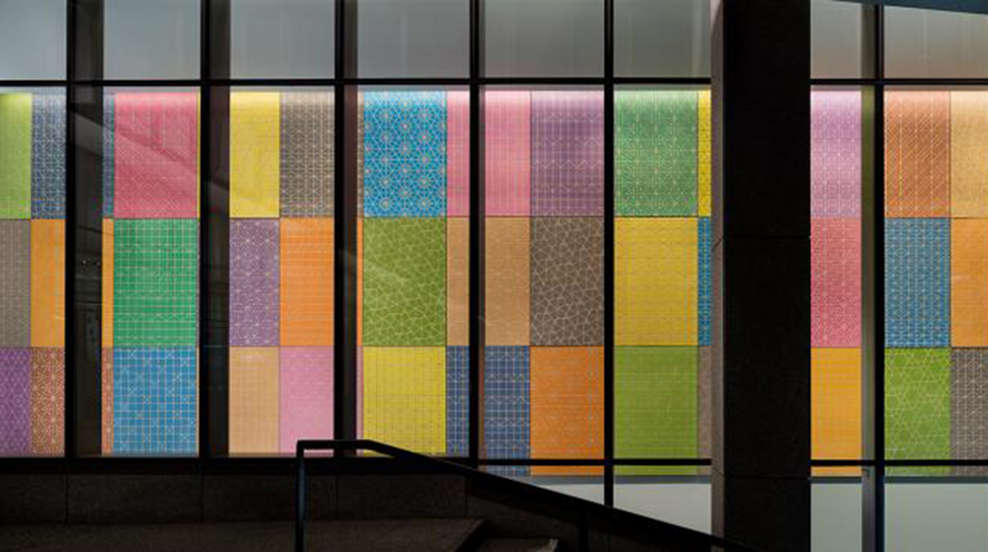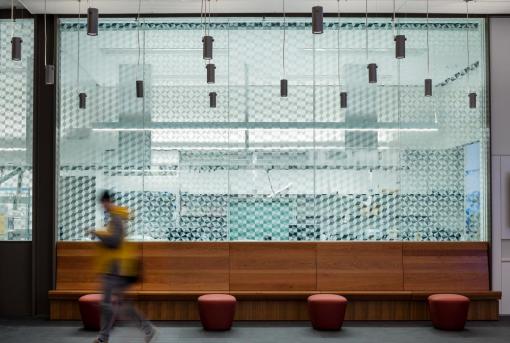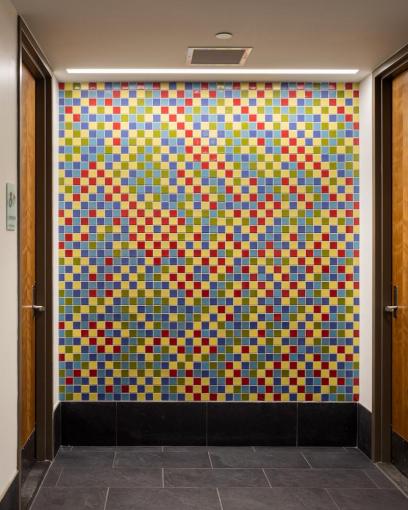
Credit: Warren Jagger
On Feb. 7, renowned artist Spencer Finch will speak about 'The Garden in the Brain,' a series of works commissioned for Brown's state-of-the-art building, which opened last October.
Embedded in the walls and floors of Brown University's new Engineering Research Center are nine works of art — tiling patterns whose designs express concepts that underlie the scholarly work and research that take place in the state-of-the-art building.
The work, by New York artist Spencer Finch, is collectively called "The Garden in the Brain." It is the 10th commission through the University's percent-for-art initiative, managed by the Public Art Committee, through which 1 percent of the construction budget of all new buildings and major renovations on campus goes to artwork for the building or grounds.
On Wednesday, Feb. 7, Brown will celebrate the formal opening of the permanent installation with a lecture and reception with Finch at 4 p.m. in the Engineering Research Center at 345 Brook St. in Providence. Finch will talk about his works, their inspiration and the new commission at Brown.
"Finch is known for his poetic installations that recreate the ephemeral qualities of light and color in media as varied as watercolor, glass plates and ice cream cones," said Jo-Ann Conklin, director of the Bell Gallery at Brown and a member of the Public Art Committee.

Among his major works is his permanent installation in the National September 11 Memorial and Museum. Titled "Trying to Remember the Color of the Sky on That September Morning," the piece is a monumental work made of 2,983 individual squares of hand-painted paper.
In the Engineering Research Center, which opened in October, the largest and most visible of Finch's works is the grid of dyed and etched plywood panels installed in the hallway of the lower entrance. The work is visible from outside the building as well as within, and according to Conklin, "the panels exhibit a sophisticated use of color that is characteristic of the artist's work."
Other works in "The Garden in the Brain" are created in ceramic tile, ceramic frit glass, wood flooring and concrete pavers.
"The installations, generally speaking, fall into the category of tilings or tessellations, patterns based on an elaborate theory of symmetry," said Rod Beresford, a professor and senior associate dean for academic programs for the School of Engineering. "Many people would likely recognize them generally but might not be able to pinpoint the specific ideas represented."

More broadly, Beresford said, the works relate to the fundamental structures of matter. Material properties underlie everything engineers do, Beresford said, and that idea was something Finch discussed when he met with faculty and students to share his ideas during the design process.
Now, for example, a microelectronics researcher walking through the main hallway, washing her hands in the restroom or encountering the wall of the teaching lab may experience a jolt of recognition — that brightly colored tile or series of dots on the glass represents a mathematical theory.
Whether or not such connection are made overtly, "The Garden in the Brain" is part of Brown's effort to incorporate art into the everyday fabric of campus life, Beresford said.
"I think it's fantastic," he added. "Finch's work has a very rich field of possibilities for intersections with science or technology. It's not especially obvious or direct; it leaves a lot to the individual's perspective, but it's beautiful and very evocative."
by Gillian Kiley